Dell Launches Three Rugged Latitude Laptops with up to 1000-nit Displays
by Anton Shilov on October 23, 2018 8:01 AM EST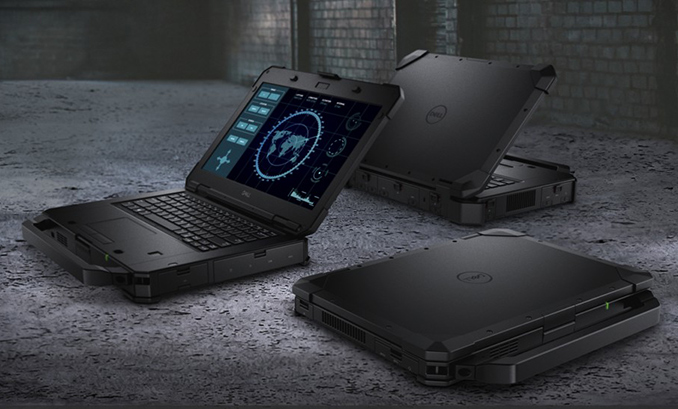
Dell today introduced its new generation of ruggedized Latitude laptops designed to operate in rough locations. The new family consists of three base models that offer different levels of protection against extreme handling and environments. The new Latitude Rugged systems are rquipped with modern CPUs and discrete GPUs, advanced security technologies, dozens of optional communication capabilities, and are compatible with Dell’s strengthened peripherals as well as various special-purpose equipment.
Dell’s 2018 Latitude Rugged lineup of notebooks includes three base models.
The flagship Latitude 7424 Rugged Extreme offers the best possible protection against extreme handling and environments along with a variety of options when it comes to storage (e.g., it has up to three SSDs running in various modes, and an ODD; see the table below for details), but at the cost of portability and a rather extreme MSRP.
A little bit below sits the Latitude 5424 Rugged that has the same expandability options, but comes in somewhat less reinforced chassis and therefore is considerably cheaper and portable. In addition, Dell introduced the Latitude 5420 Rugged, a simplified version of the 5424, that loses second and third SSD options, does not have an optical disk drive, but has the same level of protection. The Latitude 5420 is the thinnest and the lightest laptop in this family - it comes with a lower price tag as well.
When it comes to performance and general capabilities, all the laptops offer the same set of features. All three models are similarly end-to-end secure and manageable, their key differences are in levels of protection against extreme handling or environments. All of them can survive a drop or two and operate under thermal extremes, yet the Rugged Extreme model is more fit for such things than the remaining two. All the new units are also compatible with existing infrastructure supporting Latitude Rugged machines, so industrial, military, and other customers can buy the new laptops knowing that they can easily replace their predecessors and will not require any additional hardware-related investments.
The new Latitude Rugged notebooks come with a 14-inch Full-HD multi-touch display that is equipped with a polarizer that enhances its readability outdoors, and is protected with a Gorilla Glass. The LCD used by Dell is one-of-a-kind since this is the industry’s first laptop monitor featuring up to 1000 nits brightness.
Moving on to internals of the systems. The new Dell Latitude Rugged machines can be outfitted with quad-core or dual-core Intel Core i3/i5/i7 processors (Skylake or Kaby Lake) that are accompanied by up to 32 GB of DDR4-2400 memory, and up to three Class 20 or Class 40 SSDs that can store up to 3 TB of data (7424 and 5424 models only). The higher-end SKUs even offer an optical drive, but the lightest one naturally does not have it for the sake of portability. For users demanding a higher performing GPU, Dell also offers optional Radeon 540/RX540 discrete graphics. Meanwhile, in a bid to keep the CPU, up to three SSDs, and a discrete graphics chipcool, Dell installed a new active cooling solution into its new laptops for extreme environments.
Since we are dealing with laptops designed to work everywhere, their communication capabilities are vast. Besides usual 802.11ac Wi-Fi and GbE, the new Dell Latitude Rugged are outfitted with an optional Qualcomm X20 4G/LTE modem (Cat 16), and a GPS card. As for general connectivity, the new units feature USB Type-A and Type-C ports, one or two RS-232 headers, an SD card reader, various display outputs (HDMI by default, DP and D-Sub are optional), and so on. Customers may also equip their Latitude Rugged systems with PCMCIA, ExpressCard, or Smart Card readers.
Moving on to battery life. All three new Dell Latitude Rugged systems feature up to two hot-swappable 51 Wh batteries (Ed: So you can only carry one spare on an aircraft? Why not 49Wh for two?). When both are installed, the laptops can operate for up to 14 hours depending on their exact configuration. Keep in mind that a 1000-nits display is very power hungry, so do not expect the notebooks to last for long when working outdoors with LCD brightness cranked up.
Dell’s new Latitude Rugged Extreme and Latitude Rugged laptops will hit the market in the coming days or weeks, depending on the region. The top-of-the-range Latitude 7424 Rugged Extreme will start at $3,499, whereas the Latitude 5424/5420 Rugged machines will start at $1,499/$1,399.
| Specifications of Dell's 2018 Latitude Rugged & Rugged Extreme Laptops | ||||
| Latitude 7424 Rugged Extreme |
Latitude 5424 Rugged | Latitude 5420 Rugged | ||
| LCD | Diagonal | 14" | ||
| Resolution | 1920×1080 | |||
| Brightness | 1000 cd/m² | |||
| Features | Outdoor-readable display with gloved multi-touch, polarizer and Gorilla Glass |
|||
| CPU | Quad-core 8th Gen Core i5/i7 with vPro Dual-core 7th Gen Core i3 Dual-core 6th Gen Core i5 for Windows 7 Pro downgrade |
|||
| Graphics | Intel HD Graphics 520/620 (24 EUs) Intel UHD Graphics 620 (24 EUs) AMD Radeon 540, AMD Radeon RX 540 discrete GPU |
|||
| RAM | 8 GB, 16 GB, 32 GB DDR4-2400 | |||
| Storage | Primary SSD | 128 GB, 256 GB, 512 GB, 1 TB, 2 TB PCIe/NVMe Class 40 256 GB, 512 GB, 1 TB PCIe/NVMe SED Class 40 |
||
| Other | 256 GB, 512 GB, 1 TB SATA Class 20 | - | ||
| ODD | DVD ROM DVD RW Blu-ray RW All ODDs replace third SSD option |
External options only | ||
| Wireless | Wi-Fi | Intel Dual Band Wireless AC 8265 (802.11ac) 2x2 with Bluetooth 4.1 Intel Dual Band Wireless AC 8265 (802.11ac) 2x2 (No BT) Qualcomm QCA61x4A 802.11ac Dual Band (2x2) with Bluetooth 4.1 |
||
| WWAN | Qualcomm Snapdragon X20 LTE (DW5821e) | |||
| GPS | Dedicated u-blox NEO-M8 GPS card | |||
| Additional | Triple RF-passthough (Wi-Fi, GPS, and mobile broadband) | |||
| GbE | 1 GbE | |||
| USB | Type-A | 3 × USB 3.0 | ||
| Type-C | 1 × USB 3.0 Type-A for power and display | |||
| Webcam | Optional integrated FHD video web or IR camera with privacy shutter |
|||
| Security | Fingerprint reader, Contactless and Contacted/SmartCard reader, TPM 2.0, ControlVault advanced authentication, Dell Backup and Recovery Dell Security Tools, Dell Data Protection/Encryption, NIST SP800-147 secure platform. |
|||
| Other I/O | TRRS audio jack, micro RS-232 (1 or 2), HDMI, D-Sub (optional), Display Port (optional). Fischer USB (optional), SD card reader, PCMCIA or Express Card (optional), POGO connector, etc. |
|||
| Battery | Primary | 51 Wh | ||
| Secondary | 51 Wh, optional | |||
| Dimensions | Width | 354.5 mm | 13.95" | 347 mm | 13.66" | 347 mm | 13.66" |
| Depth | 255 mm | 10" | 244.5 mm | 9.62" | 244.5 mm | 9.62" | |
| Thickness | 51.3 mm | 2" | 44.4 mm | 1.74" | 32.8 mm | 1.29" | |
| Weight | 3.45 kg | 7.6 lbs | 2.5 kg | 5.5 lbs | 2.22 kg | 4.9 lbs | |
| Operating System | Microsoft Windows 10 Pro 64 Bit Windows 7 Professional Downgrade (64 bit) - Skylake CPU required |
|||
| Regulatory and Environmental Compliance | MIL-STD-810G | Transit drop: 72”/1.82m, single unit, 78 drops; | Transit drop: 36”/0.91m, single unit, 26 drops; |
|
| Operating drop: 36”/0.91m | ||||
| Blowing dust, vibration, functional shock, humidity, altitude, thermal extremes |
||||
| Blowing rain, blowng sand, salt fog (with rubberized keyboard), explosive atmosphere, solar radiation, thermal shock, freeze/thaw, tactical standby to operational. |
- | |||
| Thermal range | Operating: -20°F to 145°F (-29°C to 63°C); Non-operating: -60°F to 160°F (-51°C to 71°C). |
|||
| IEC 60529 ingress protection | IP-65 (dust-tight, protected against pressurized water) | IP-52 (dust-protected, protected against dripping water when tilted up to 15°) | ||
| Optional Accessories | Rugged desk dock, Havis vehicle dock, Dell WD15 monitor dock Dell auto air DC adapter Gamber-Johnson vehicle dock Dell Rugged shoulder strap Dell power adapters and power banks Dell displays |
|||
| Price | Starting at $3,499 | Starting at $1,499 | Starting at $1,399 | |
Related Reading:
Source: Dell


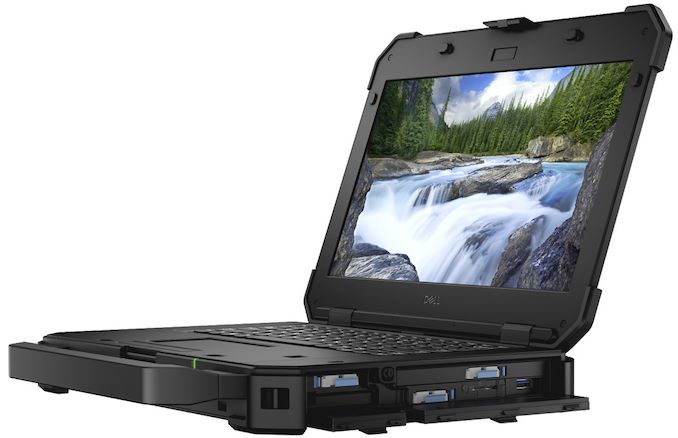
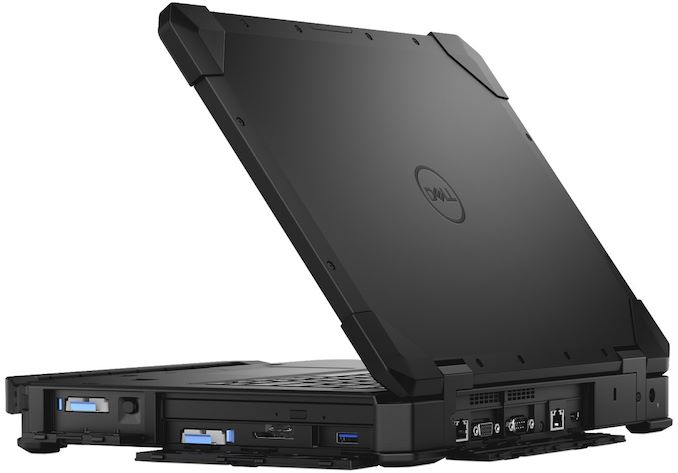
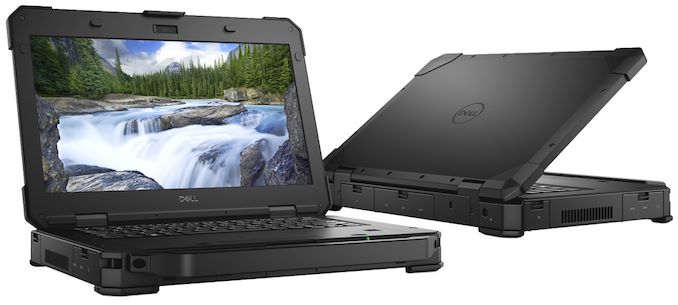
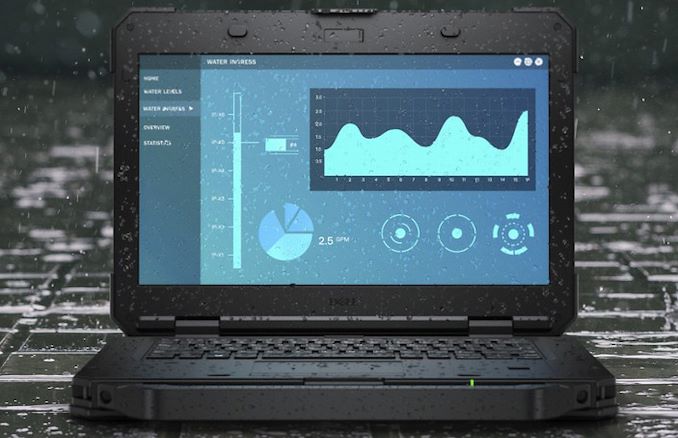
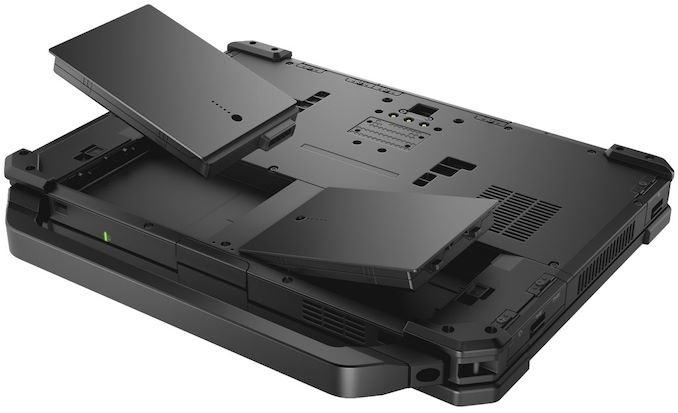








7 Comments
View All Comments
Dragonstongue - Tuesday, October 23, 2018 - link
equipped with modern cpu (but not ryzen of any kind)crud for battery capacity (why does every company seem to do these things, especially when they know the component selection is power hungry)
granted they are "rugged" the price these are slotted for and the specs given are out to lunch IMHO...I like the battery design, shame that is the only "redeeming quality" I see here.
Inteli - Tuesday, October 23, 2018 - link
These sorts of laptops have *always* been this expensive, because it costs more money to engineer and test than a normal laptop. Let me know when you find a laptop as durable as this one for what you'd consider a "reasonable" price.Dug - Tuesday, October 23, 2018 - link
Are you kidding? That is extremely cheap, especially the 7424. There's a reason it's 7.6lbs. I don't think you have much knowledge on laptops in extreme conditions, nor what these are geared for.JoeyJoJo123 - Tuesday, October 23, 2018 - link
>crud for battery capacitySeriously? These Dell models have two 51 Wh battery slots that are hot swappable. If battery life is a concern, the company buying these devices would order additional battery banks so that you can hotswap them in as necessary while other batteries are charging. This should be an absolute non-issue even in rugged environments where there is no access (or meager access to) power outlets.
This junk is exactly why the whining entitled posts on Anandtech article comment sections are the worst. Just leave, dude.
philehidiot - Tuesday, October 23, 2018 - link
Personally I think these are extremely well priced. Battery life will depend on use but these don't seem bad. The cost of developing this kind of kit combined with a relatively niche market means it is going to be expensive but this kind of price puts it in the reach of photographers who are going to remote places and so on rather than just industrial / emergency services / military uses which has often been the case in the past.PeachNCream - Tuesday, October 23, 2018 - link
We had some problems with Dell's much older rugged laptops like the e6400 XFR. The "Ballistic Armor" casings had a tendency to develop fractures, but Dell quickly iterated and when the organization I worked for at the time started to get Sandy Bridge-era replacements in on life cycle, we had much better results from the field. I work at a different place that has no need for rugged laptops, but I'd still love to poke these things to see how they've changed.bineti - Sunday, January 6, 2019 - link
i think its not for portability. since the computer is heavily loaded with hardwares. how about the replacements? https://www.mybkexperience.org/